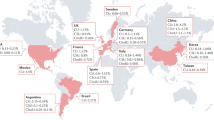Abstract
Urticaria is one of the most common skin diseases that impairs the quality of life in patients. According to the duration of symptoms with less or more than 6 weeks urticaria is subdivided into acute or chronic spontaneous. Non-sedating antihistamines are the main stay for therapy in urticaria, however some patients do not respond to updosing, which is not licensed but recommended by the latest European guideline. In those patients anti-IgE, which is licensed for urticaria therapy, is recommended besides the recommendation of cyclosporine A, which is not licensed. In this chapter we give an overview of urticaria and subtypes with reference to the latest treatment and diagnostic algorithms.
Access this chapter
Tax calculation will be finalised at checkout
Purchases are for personal use only
Similar content being viewed by others
References
Zuberbier T, Aberer W, Asero R, et al. The EAACI/GA(2) LEN/EDF/WAO Guideline for the definition, classification, diagnosis, and management of urticaria: the 2013 revision and update. Allergy. 2014;69:868–87.
Grattan CEH, Humphreys F. Guidelines for evaluation and management of urticaria in adults and children. Br J Dermatol. 2007;157:1116–23.
Powell RJ, Leech SC, Till S, et al. BSACI guideline for the management of chronic urticaria and angioedema. Clin Exp Allergy. 2015;45:547–65.
Cooper KD. Urticaria and angioedema: diagnosis and evaluation. J Am Acad Dermatol. 1991;25:166–74.
Wedi B, Raap U, Kapp A. Chronic urticaria and infections. Curr Opin Allergy Clin Immunol. 2004;4:387–96.
Raap U, Liekenbrocker T, Wieczorek D, et al. New therapeutic strategies for the different subtypes of urticaria. Hautarzt. 2004;55:361–6.
Maurer M, Staubach P, Raap U, et al. ATTENTUS, a German online survey of patients with chronic urticaria highlighting the burden of disease, unmet needs and real-life clinical practice. Br J Dermatol. 2016;174(4):892–4.
Wedi B, Kapp A. Urticaria and angioedema. In: Mahmoudi M, editor. Allergy: practical diagnosis and management. New York: Mc Graw Hill; 2007.
Elias J, Boss E, Kaplan AP. Studies of the cellular infiltrate of chronic idiopathic urticaria: prominence of T-lymphocytes, monocytes, and mast cells. J Allergy Clin Immunol. 1986;78:914–8.
Sabroe RA, Poon E, Orchard GE, et al. Cutaneous inflammatory cell infiltrate in chronic idiopathic urticaria: comparison of patients with and without anti-FcepsilonRI or anti-IgE autoantibodies. J Allergy Clin Immunol. 1999;103:484–93.
Caproni M, Giomi B, Melani L, et al. Cellular infiltrate and related cytokines, chemokines, chemokine receptors and adhesion molecules in chronic autoimmune urticaria: comparison between spontaneous and autologous serum skin test induced wheal. Int J Immunopathol Pharmacol. 2006;19:507–15.
Leslie TA. Itch. Medicine. 2013;41(7):367–71.
Yosipovitch G, Goon A, Wee J, et al. The prevalence and clinical characteristics of pruritus among patients with extensive psoriasis. Br J Dermatol. 2000;143:969–73.
Yosipovitch G, Ansari N, Goon A, et al. Clinical characteristics of pruritus in chronic idiopathic urticaria. Br J Dermatol. 2002;147:32–6.
Stander S, Zeidler C, Riepe C, et al. European EADV network on assessment of severity and burden of Pruritus (PruNet): first meeting on outcome tools. J Eur Acad Dermatol Venereol. 2015. doi: 10.1111/jdv.13296. [Epub ahead of print].
Raap U, Gieler U, Schmid-Ott G. Urticaria. Dermatol Psychosom. 2004;5:203–5.
Finlay AY, Khan GK. Dermatology Life Quality Index (DLQI) – a simple practical measure for routine clinical use. Clin Exp Dermatol. 1994;19(3):210–6.
Mathias SD, Crosby RD, Zazzali JL, Maurer M, Saini SS. Evaluating the minimally important difference of the urticaria activity score and other measures of disease activity in patients with chronic idiopathic urticaria. Ann Allergy Asthma Immunol: Off Publ Am Coll Allergy Asthma Immunol. 2012;108(1):20–4.
Baiardini I, Pasquali M, Braido F, et al. A new tool to evaluate the impact of chronic urticaria on quality of life: chronic urticaria quality of life questionnaire (CU-QoL). Allergy. 2005;60(8):1073–8.
Wedi B, Kapp A. Evidence-based therapy of chronic urticaria. J Dtsch Dermatol Ges. 2007;5:146–57.
Borzova E, Grattan CE. Urticaria: current future treatments. Expert Rev Dermatol. 2007;2(3):317–34.
Agostoni A, Aygoren-Pursun E, Binkley KE, et al. Hereditary and acquired angioedema: problems and progress: proceedings of the third C1 esterase inhibitor deficiency workshop and beyond. J Allergy Clin Immunol. 2004;114:S51–131.
Kaplan AP, Greaves MW. Angioedema. J Am Acad Dermatol. 2005;53:373–88.
Zuberbier T, Bindslev-Jensen C, Canonica W, et al. EAACI/GA2LEN/EDF guideline: management of urticaria. Allergy. 2006;61:321–31.
Leslie TA. Antihistamines. In: Wakelin SH, Maibach HI, Archer CB, editors. Handbook of systemic drug treatment in dermatology. Abingdon: Taylor & Francis Group; 2015. p. 76–84.
Savic S, Marsland A, McKay D, et al. Retrospective case note review of chronic spontaneous urticaria outcomes and adverse effects in patients treated with omalizumab or ciclosporin in UK secondary care. Allergy Asthma Clin Immunol: Off J Can Soc Allergy Clin Immunol. 2015;11(1):21.
Leslie TA, Greaves MW, Yosipovitch G. Current topical and systemic treatment of itch. Handb Exp Pharmacol. 2015;226:337–56.
Author information
Authors and Affiliations
Corresponding author
Editor information
Editors and Affiliations
Rights and permissions
Copyright information
© 2016 Springer-Verlag London
About this chapter
Cite this chapter
Leslie, T.A., Raap, U. (2016). Urticaria. In: Misery, L., Ständer, S. (eds) Pruritus. Springer, Cham. https://doi.org/10.1007/978-3-319-33142-3_21
Download citation
DOI: https://doi.org/10.1007/978-3-319-33142-3_21
Published:
Publisher Name: Springer, Cham
Print ISBN: 978-3-319-33140-9
Online ISBN: 978-3-319-33142-3
eBook Packages: MedicineMedicine (R0)




